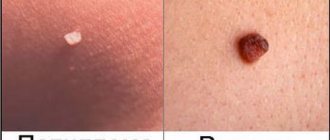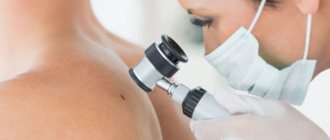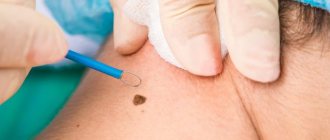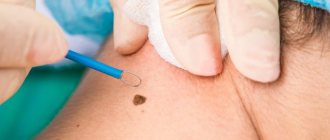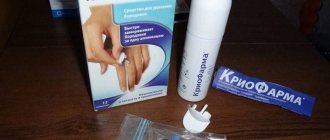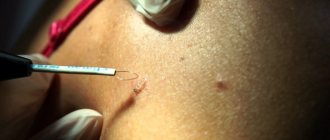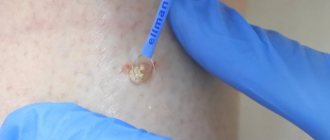Inconspicuous and often small growths on the skin - papillomas - in fact, can be a serious threat to the human body. In addition to the fact that papillomas disrupt the aesthetic appearance, they can also negatively affect health. Papillomas can develop into a malignant formation. There are many modern techniques for removing papillomas, including electrocoagulation. Electrocoagulation is a medical procedure that involves cauterization of soft tissue or removal of benign formations through the action of electric current. The frequency and strength of the current applied to the device is controlled directly by the surgeon. The device itself contains a special electrode or loop for removing tumors.
Why you need to get rid of tumors
The content of the article
Moles, papillomas, polyps, warts and other neoplasms not only look unsightly, but also cause inconvenience - they become injured, bleed, become inflamed, hurt, grow and fester. Erosion of the cervix, which causes contact bleeding, heavy discharge and provokes inflammatory processes, is no less troublesome. But the most dangerous thing is the degeneration of these formations into cancer, so you need to get rid of pathological formations.
Traditional methods of tumor removal: painful, dangerous and ugly
Surgical
– the doctor, under local anesthesia, excises the formation and sutures the skin. The procedure takes 30 minutes or more. After the stitches are removed, scars and even serious scars remain, which are not always “erased” by skin polishing.
The surgical method of removing tumors is positioned as simple and cheap. But, if you consider the amount that you have to pay to get rid of scars, you can argue with such a statement. After surgical removal of several formations, the costs of eliminating the consequences will be considerable, not counting the time spent on restorative procedures.
Electrocoagulation
- a method of removing formations from the skin and mucous membranes using high voltage current. Electricity is supplied through a metal loop, so the procedure is reminiscent of wood burning.
After local anesthesia, a mole, papilloma or wart is “burned” by electric current, and in its place a scab is formed - a crust, under which tissue healing occurs within 10-14 days.
Although the electrocoagulation method is preferable to the surgical one, it is also not without its drawbacks.
- Does not allow you to control the depth of current penetration
, so there is a high risk of cauterizing the tissue too deeply; After the procedure, a whitish scar remains, noticeable against the general background of darker skin. It's difficult to get rid of it. - Weak selectivity
. When cauterized, healthy tissues are damaged. The doctor can “overdo it”, taking too much of the surrounding skin, and a keloid scar remains on the body, and even worse, on the face after healing.
The use of electrical destruction in the treatment of cervical erosion leads to the formation of scar tissue, which interferes with the opening of the cervix during childbirth and provokes ruptures.
Are there any special recommendations for skin care after the removal procedure?
We issue the following recommendations in the form of a reminder to our patients:
- During the first 24 hours, do not wet the removal site.
- Treat the wound with Fukortsin solution 2 times a day for 3-5 days or Baneocin powder.
- Men: do not shave in the area of removal for 3-4 days.
- Women: do not apply cream or decorative cosmetics to the removal area for 3-4 days.
- You cannot pick or remove the crust yourself!!! in order to reduce the likelihood of atrophic/keloid scars, hypo- and hyperpigmentation.
- In cases of removal of large tumors, after the crust is rejected, apply Levomekol ointment locally 1-2 times a day for a month.
- Before going outside, be sure to use sunscreen on the face and open areas of the body with an SPF of at least 50, especially on sunny days (to prevent pigmentation of the treated areas).
Cold and chemical removal of warts, moles, condylomas: there are more disadvantages than advantages
Cryodestruction
- exposure to the formation of a refrigerant (usually liquid nitrogen), freezing at a temperature of - 190 degrees, sufficient to destroy the tissues of the formation. Unlike a scalpel and current, cryodestruction does not leave scarring, so it can be used on any area of the skin and mucous membranes, even on the cervix. Liquid nitrogen is used in the treatment of erosion in nulliparous women.
The cold itself “freezes” the tissue, so anesthesia during cryodestruction is not necessary. This makes the technique convenient for treating patients who are allergic to anesthetics.
The main disadvantage of the method is the impossibility of accurately adjusting the depth and area of penetration of the coolant into the tissue. With weak treatment, unremoved cells remain, leading to relapse, and too deep treatment leads to the destruction of melanin pigment and the appearance of hypopigmentation - white spots that are difficult to get rid of.
After unsuccessful cryodestruction, poorly healing blisters and ulcers appear on the skin, caused by frostbite of the tissue around the removed formation.
Cauterization with various chemical solutions works in approximately the same way - feresol, condiline, verrucacid and other drugs that act on the skin with acids, alkalis and aggressive organic components (phenol, tricresol).
The disadvantage of their use is low selectivity. Along with the altered tissues, healthy ones that are affected by the substance also suffer, and sometimes part of the formation remains, leading to a relapse. This situation is especially dangerous when removing moles. After a chemical burn, nevi that are not completely removed become inflamed and can develop into an aggressive cancerous tumor - melanoma. The chemical components included in the preparations are dangerous for people with a tendency to allergic reactions.
Currently, agents are used to remove tumors that have an antiviral effect. They are effective against papillomas and warts, but growths of non-viral origin, such as moles or hemangiomas, cannot be removed with their help.
How is electrocoagulation performed?
The procedure does not require any preparation from the patient: he needs to come to the urologist’s office on time and inform him of the presence of an allergic reaction to anesthesia or the presence of certain diseases.
During the procedure, the doctor uses an electrocoagulator. The impact is carried out by an electrode, which has the form of a steel loop, to which a high-frequency electric current is supplied.
Before starting the procedure, the patient is asked to sit in a urological chair and the affected area is treated with antiseptic and anesthetized. After this, the urologist begins electrocoagulation, during which he applies an electrode to the base of the condylomas, burning them out.
Depending on how many condylomas need to be removed, the duration of the procedure can be from ten to thirty minutes. If the neoplasm is large, it is sent for histology. This is a diagnostic tissue test that allows you to determine the nature of condyloma.
Modern methods of removing warts, moles, condylomas, papillomas, polyps
There are only 2 such methods so far - removal of tumors by laser and radio wave method.
Laser method for tumor removal
Laser -
is based on the use of a laser that “evaporates” the formation with a light beam. The method has many advantages:
- Selectivity.
Each tissue reacts to certain parameters of the waves, so the device affects the affected tissues without affecting healthy ones. During the procedure, the doctor can change the tinctures, reducing or increasing the strength and depth of effect. - Low trauma
- the method does not cause extensive tissue damage, chemical and thermal burns, swelling, blisters and severe pain. - Healing times after laser treatment
are shorter than when using electricity, scalpel or liquid nitrogen. A brownish crust forms at the site of exposure, under which new skin forms. After the procedure, there are no scars, scars or areas without pigmentation. - The laser has an antimicrobial and antiviral effect, eliminating the occurrence of relapses. By acting on blood vessels, it prevents bleeding.
- The procedure takes only 5-10 minutes, and the injected anesthetics make it painless. In one session you can get rid of all formations at once.
Radio wave method for removing any tumors
The radio wave method is the most modern method for removing any tumors —
papillomas, condylomas, warts, polyps, moles, etc.
Formations are removed using high-frequency waves. Radio radiation heats the cells of the tumor, the water in them boils, tearing the tissue of the growth. A hot radio knife “cuts off” a wart, mole, etc., cauterizing tissue and blood vessels and preventing bleeding. Removal takes 5-10 minutes.
The treatment site is treated with an anesthetic and the procedure does not cause pain. There are no burns, scars, or blisters left on the skin. Fine adjustment of the operation of the radio knife allows minimal trauma to neighboring tissues, reducing healing time.
After exposure to radio wave radiation, a crust remains on the skin, under which healthy tissue is formed. There is no skin treatment after the procedure. After the crust falls off, smooth skin without scars or areas of disturbed pigmentation remains.
The gentle effect of the radio knife allows you to remove formations even in delicate places - on the genitals, face, mammary glands. Relapse is completely excluded.
Outdated traumatic methods for removing formations on the skin and mucous membranes are disappearing, giving way to modern techniques - laser and high-frequency waves.
Cryodestruction
Cryodestruction is a method of local exposure to low temperatures in order to destroy pathological tissues. The source of low temperature in this case is liquid nitrogen, the boiling point of which is - 196°C.
The cryodestruction process is divided into the following stages:
- Freezing tissue using liquid nitrogen. Due to sudden cooling, the skin becomes denser and sensitivity is temporarily lost. The patient feels a slight tingling or burning sensation, and minor discomfort is possible.
- Then collateral edema and hyperemia occurs. This stage can last from 1 to 3 hours.
- The next stage is the appearance of an epidermal blister, which disappears within a few days.
- In the period from 2 to 6 weeks, complete rejection of necrosis occurs. An inconspicuous pink spot remains at the site of the manipulation, followed by complete tissue regeneration within 6 months.
Advantages:
- Does not require anesthesia, as rapid cooling produces an analgesic effect.
- Does not provoke gross scar changes.
- The area of necrosis does not bleed.
- Lack of preoperative preparation.
- The speed of the method.
- Minimal injury.
Removal of benign formations can be carried out for both aesthetic and medical reasons.
Where to remove a mole, polyp, condylomas, papilloma or wart in St. Petersburg
At the Diana St. Petersburg Medical Center, all methods of removing tumors are used, but preference is given to modern laser and radio wave techniques. The clinic has the latest radio wave apparatus. Treatment is carried out without pain and complications under ideal sterile conditions.
Here you can take tests for oncology and blood clotting, undergo all types of ultrasound, get advice from a urologist, gynecologist, dermatologist and oncologist. All doctors have the highest qualification category and extensive experience.
Contraindications for carrying out
The procedure is strictly contraindicated for patients with individual intolerance to electrical procedures or painkillers, hereditary or acquired bleeding disorders, acute infectious or somatic diseases, as well as chronic ones during exacerbation.
The method is contraindicated in the presence of an electrical pacemaker, malignant neoplasm, active herpes, or inflammatory skin diseases. The procedure cannot be performed during pregnancy or lactation.
The procedure is prescribed very carefully to patients with diabetes mellitus, as well as to those who are predisposed to the formation of keloid scars.


